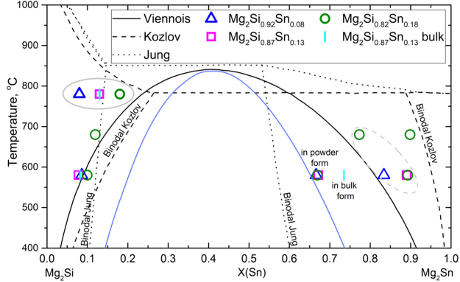Influence of Phase Separation and Spinodal Decomposition on Microstructure of Mg2Si1–xSnx Alloys
A. Sizov,
H. Reardon,
B. B. Iversen,
P. Erhart,
and
A. E. C. Palmqvist
Crystal Growth & Design 19, 4927
(2019)
doi: 10.1021/acs.cgd.9b00013

Mg2Si1–xSnx alloys with nominal values of x [0.03:0.18] were synthesized at 780°C by solid-state reaction from Mg2Si and Mg2Sn and subsequently annealed at either 680 or 580°C. Their microstructure was investigated by X-ray diffraction using the Rietveld method. Depending on the treatment temperature and the nominal composition, the solid solutions split into different Si- and/or Sn-rich Mg2Si1–xSnx phases. Traces of spinodal decomposition were observed for the samples with a low Sn content independent of treatment temperature due to the limited diffusion kinetics when entering the miscibility gap. A similar effect was observed when applying a higher cooling rate to the samples with higher Sn concentration. In this case, the samples experience thermodynamic spinodal decomposition being located in the spinodal region sufficiently long time at higher temperatures. Samples treated in the miscibility gap showed an agreement of the Si-rich binodal line with calculated phase diagrams. However, the Sn-rich binodal line stays undefined, perhaps due to grain boundary pinning of diffusing atoms. The study elucidates the possibility of tailoring the microstructure of magnesium silicide-stannide alloys utilizing merely judiciously designed heat treatment protocols. A particular attention is brought to spinodal decomposition, which has the potential to reduce the lattice thermal conductivity.